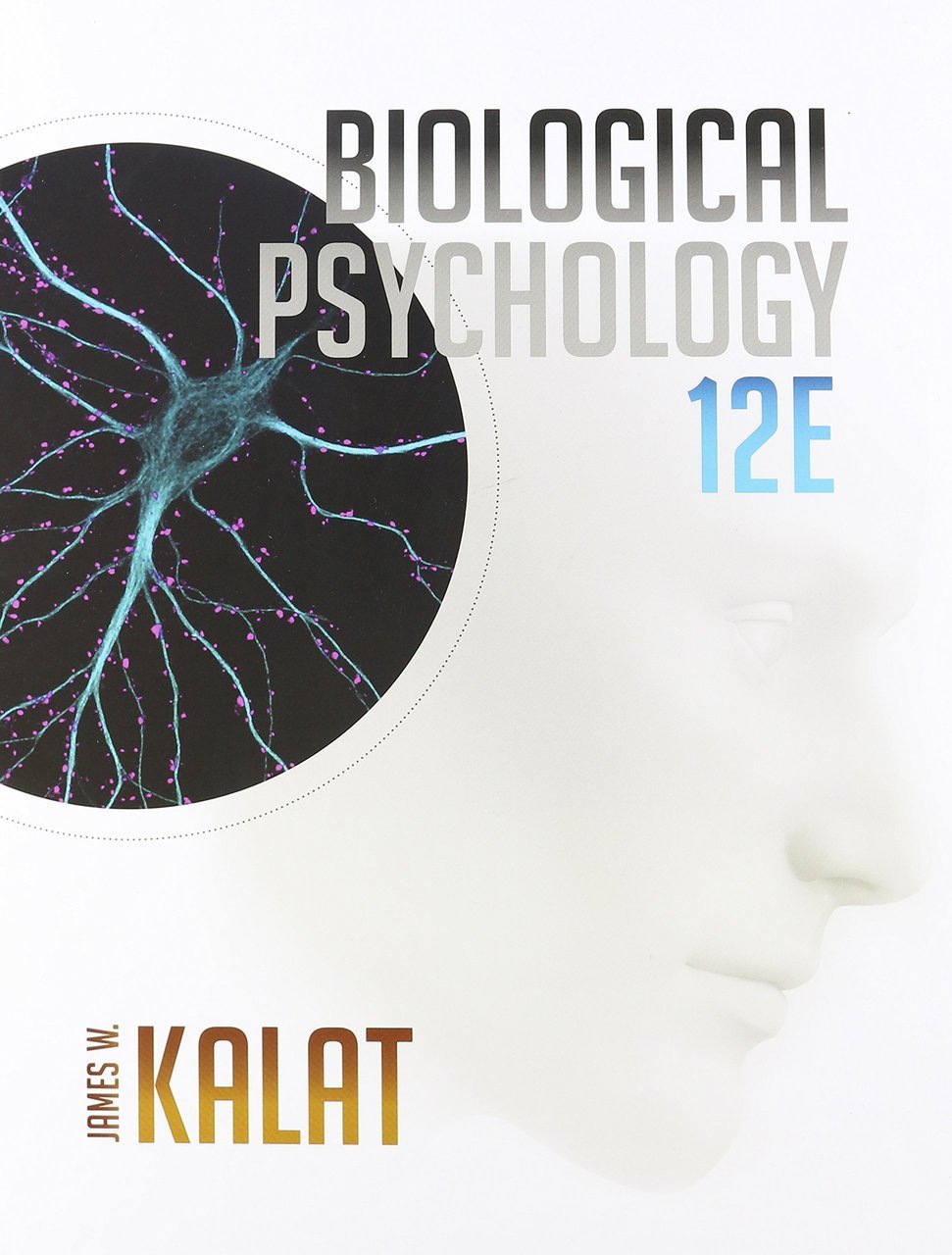Instant download Biological Psychology Kalat 12th Edition Solutions Manual pdf docx epub after payment.

CHAPTER 1
NERVE CELLS AND NERVE IMPULSES
Chapter Outline
- The Cells of the Nervous System
- Neurons and Glia
- The nervous system is composed of two types of cells: neurons and glia.
- Neurons: Receive information and transmit it to other cells.
- Glia: Serve many functions that are difficult to summarize.
- The human brain contains approximately 100 billion neurons (though that estimate varies from person to person).
- Santiago Ramón y Cajal (1852-1934), a Pioneer of Neuroscience
- Used staining techniques to reveal that small gaps separate the tips of one neuron from another. This discovery showed that the brain—like the rest of the body—is composed of individual cells.
- The Structure of an Animal Cell
- Neurons contain the same basic structures of other animal cells.
- Membrane (plasma membrane): Composed of two layers of fat molecules, this membrane allows some small uncharged chemicals to flow both into and out of the cell. Protein channels allow a few charged ions to cross the membrane, but most chemicals are unable to cross.
- Nucleus: The structure that contains the chromosomes.
- Mitochondrion: The structure that provides the cell with energy. It requires fuel and oxygen to function.
- Ribosomes: Site of protein synthesis in the cell.
- Endoplasmic reticulum: A network of thin tubes that transports newly synthesized proteins to other locations. Ribosomes may be attached.
- The Structure of a Neuron
- The most distinctive structural feature of neurons is their shape, which varies enormously.
- Larger neurons contain four major components: dendrites, cell body, axon, and presynaptic terminal. The tiniest neurons may lack axons and well-defined dendrites. Compare the structure of these components in the following two types of neurons:
- A motor neuron: Conducts impulses to muscles and glands from the spinal cord.
- A sensory neuron (receptor neurons): Sensitive to certain kinds of stimulation (e.g., light, touch, etc.).
- Neuron components:
- Dendrites: Branching fibers that extend from the cell body and get narrower at their end. The dendrite’s surface is lined with specialized synaptic receptors, at which the dendrite receives information from other neurons.
- Dendritic spines: Short outgrowths found on some dendritic branches.
- The Structure of a Neuron
- Cell body (soma): Contains the nucleus, ribosomes, mitochondria, and other structures found in most cells.
- Axon: A long, thin fiber (usually longer than dendrites), which is the information-sending part of the neuron, sending an electrical impulse toward other neurons, glands, or muscles.
- Myelin sheath: Insulating covering found on some vertebrate axons.
- Nodes of Ranvier: Interruptions along the myelin sheath.
- Presynaptic terminal (end bulb): Swelling at the tip of the axon. The part of the neuron that releases chemicals that cross the junction between one neuron and the next.
- Neurons may have any number of dendrites, but are limited to no more than one axon (which may have branches).
- Other terms associated with neurons:
- Afferent axons: Brings information into a structure.
- Efferent axons: Sends information away from a structure.
- Interneurons (intrinsic neurons): Entirely located within a single structure of the nervous system.
- Variations among Neurons
- Neurons vary enormously in size, shape, and function.
- A neuron’s function is closely related to its shape.
- A neuron’s shape is plastic (changeable) as new experiences can modify the shape of a neuron.
- Glia
- Glia (neuroglia) are the other major component of the nervous system. Glia have many different functions but they do not transmit information like neurons.
- Glia are smaller and more numerous than neurons. Several types of glia exists to perform different functions.
- Astrocytes: A type of glia that absorbs chemicals released by axons and later returns those chemicals back to the axon to help synchronize the activity of neurons. Astrocytes remove waste products as well, particularly those created after neurons die. Astrocytes also cause blood vessels to dilate to bring in more nutrients at times of increased brain activity. They act as a recycling system for glutamate released by neurons (absorbing excess glutamate then converting it to glutamine and passing it back into the neurons).
- Microglia: Very small cells that remove waste material as well as viruses, fungi, and other microorganisms.
- Oligodendrocytes: A type of glia that builds the myelin sheaths around certain neurons in the brain and spinal cord.
- Schwann cells: A type of glia that builds the myelin sheaths around certain neurons in the periphery of the body.
- Radial glia: Guides the migration of neurons and the growth of axons and dendrites during embryonic development.
- The Blood-Brain Barrier
- The mechanism that keeps most chemicals out of the vertebrate brain.
- Why We Need a Blood-Brain Barrier
- The blood-brain barrier is needed because the brain lacks the type of immune system present in the rest of the body.
- Because neurons cannot be replicated and replaced, the barrier is in place to minimize the risk of irreparable brain damage.
- A wall is formed that keeps out most viruses, bacteria, and harmful chemicals.
- When viruses do enter, like the rabies virus, it can infect the brain and lead to death.
- A virus that enters your nervous system probably stays with you for life (e.g., chicken pox and shingles).
- How the Blood-Brain Barrier Works
- Endothelial cells form walls of the capillaries. These cells are tightly joined in the brain, blocking most molecules from passing. In the rest of the body, the endothelial cells are separated by large gaps.
- Small uncharged molecules (e.g., oxygen and carbon dioxide) and molecules that can dissolve in the fats of the capillary wall can cross passively (without using energy) through the blood-brain barrier.
- An active transport system (a protein-mediated process that uses energy) exists to pump necessary chemicals, such as glucose, through the blood-brain barrier.
- The blood-brain barrier is essential for health. For example, in Alzheimer’s disease, the endothelial cells lining the brain’s blood vessels shrink and harmful chemicals can enter the brain.
- The blood-brain barrier poses difficulty in medicine because it keeps out many useful medications that may be used to treat diseases like brain cancer.
- Nourishment of Vertebrate Neurons
- Almost all neurons depend on glucose (a simple sugar) for their nutrition.
- Neurons rely on glucose so heavily because glucose is practically the only nutrient that crosses the blood-brain barrier in adults. Ketones can also cross but are in short supply.
- A thiamine (vitamin B1) deficiency leads to an inability to use glucose, which could lead to neuron death and a condition called Korsakoff’s syndrome (a disorder marked by severe memory impairment).
- Nourishment of Vertebrate Neurons
- The Nerve Impulse
- The Resting Potential of the Neuron
- The membrane of a neuron maintains an electrical gradient (a difference in electrical charge between the inside and outside of the cell).
- In the absence of any outside disturbance (i.e., at rest), the membrane maintains an electrical polarization (i.e., a difference in electrical charge between two locations) that is slightly more negative on the inside relative to the outside. This difference in electrical potential or voltage is known as the resting potential.
- The resting potential is measured by very thin microelectrodes. A typical resting membrane potential is -70 millivolts (mV). This may vary from one neuron to another.
- The Resting Potential of the Neuron
- Forces Acting on Sodium and Potassium Ions:
- The neuron membrane is selectively permeable, which allows some molecules to pass freely (e.g., water, carbon dioxide, oxygen) while restricting others. Most large molecules and ions cannot cross the membrane. A few important ions cross through protein channels.
- During the resting potential, chloride channels (or gates) remain open along the membrane, which allows ions to pass through. Potassium channels are mostly closed, causing potassium to cross the membrane slowly. Sodium gates remain closed, restricting the passage of sodium ions.
- Sodium-potassium pump: a protein complex found along the neuron membrane that transports three sodium ions outside of the cell while also drawing two potassium ions into the cell; this is an active transport mechanism (requires energy to function). The sodium-potassium pump causes sodium ions to be more than ten times more concentrated outside than inside.
- When the membrane is at rest, two forces work on sodium ions:
- The electrical gradient: opposite electrical charges attract, so sodium (which is positively charged) is attracted to the negative charge inside the cell.
- The concentration gradient (difference in distribution of ions between the inside and the outside of the membrane): Sodium is more concentrated outside the membrane than inside and is thus more likely to enter the cell than to leave it.
- Given that both the electrical and concentration gradients tend to move sodium into the cell, sodium would be expected to quickly enter the cell. However, when the membrane is at rest, sodium channels are closed.
- Potassium ions are subject to the same two forces; however, the forces are in opposition to each other. Potassium ions are positively charged, so the electrical gradient tends to move potassium in, but since potassium is concentrated on the inside of the cell, the concentration gradient causes potassium to flow out of the cell.
- Why a Resting Potential?
- The advantage of the resting potential is to allow the neuron to respond quickly to a stimulus.
- The Action Potential
- Action potential: Messages sent by axons.
- Hyperpolarization (increased polarization): Occurs when the negative charge inside the axon increases (e.g., -70 mV becomes -80 mV).
- Depolarization (reduce polarization towards zero): Occurs when the negative charge inside the axon decreases (e.g., -70 mV becomes -55 mV).
- Threshold of excitation: The level that a depolarization must reach for an action potential to occur. A subthreshold stimulation produces a small response proportional to the amount of current. However, as long as the stimulation is above the threshold, regardless of how far beyond, the stimulation produces a big response.
- The Molecular Basis of the Action Potential
- Principles of the action potential:
- At the start, sodium ions are mostly outside the neuron and potassium ions are mostly inside.
- When the membrane depolarizes, sodium and potassium channels in the membrane open.
- The Action Potential
- Potassium ions are subject to the same two forces; however, the forces are in opposition to each other. Potassium ions are positively charged, so the electrical gradient tends to move potassium in, but since potassium is concentrated on the inside of the cell, the concentration gradient causes potassium to flow out of the cell.
iii. At the peak of the action potential, the sodium channels close.
- Voltage-gated channels regulate channels of sodium and potassium. Their permeability depends on the voltage difference across the membrane.
- When the action potential reaches its peak, voltage-activated sodium gates close, and voltage-gated potassium channels open, allowing potassium ions to flow outside of the membrane due to their high concentration inside the neuron as opposed to outside. Also, the electrical gradient is now pushing the potassium to flow outward.
- A temporary hyperpolarization (membrane potential below the resting potential) occurs before the membrane returns to its normal resting potential (this is due to potassium gates opening wider than usual, allowing potassium to continue to exit past the resting potential).
- After the action potential, the neuron has more sodium and fewer potassium ions for a short period (this is soon adjusted by the sodium-potassium pumps to the neuron’s original concentration gradient).
- The sodium-potassium pump does not restore the resting membrane potential; diffusion does. Fewer than 1% of the total sodium ions present cross the membrane during an action potential.
- Local anesthetic drugs (e.g., Novocain, Xylocaine, etc.) block the occurrence of action potentials by blocking voltage-activated sodium gates (preventing sodium from entering a membrane).
- Action potentials only occur in axons as cell bodies; dendrites do not have voltage-dependent channels.
- The All-or-None Law
- The all-or-none law means that the amplitude and velocity of an action potential are independent of the intensity of the stimulus that initiated it.
- If the threshold is met or exceeded, an action potential of a specific magnitude will occur; if the threshold is not met, an action potential will not occur.
- The Refractory Period
- The refractory period is a period immediately after an action potential occurs when the neuron will resist the production of another action potential.
- Absolute refractory period: Sodium gates are incapable of opening; hence, an action potential cannot occur, regardless of the amount of stimulation.
- Relative refractory period: Sodium gates are capable of opening, but potassium channels remain open; a stronger than normal stimulus (i.e., exceeding threshold) will initiate an action potential.
- In most neurons, the absolute refractory period is about 1 ms and the relative refractory period is another 2-4 ms.
- Propagation of the Action Potential
- The action potential begins at the axon hillock (a swelling located where the axon exits the cell body).
- The action potential is regenerated due to sodium ions moving down the axon, depolarizing adjacent areas of the membrane.
- Propagation of the action potential: Transmission (movement) of an action potential down an axon. The action potential moves down the axon by regenerating itself at successive points on the axon.
- The refractory periods prevent the action potentials from moving in the opposite direction (i.e., toward the axon hillock).
- The Myelin Sheath and Saltatory Conduction
- Myelin: An insulating material composed of fats and proteins found on some vertebrate axons. Myelin greatly increases the speed of propagation.
- Myelinated axons: Axons covered with a myelin sheath, found only in vertebrates.
- Nodes of Ranvier: Short, unmyelinated sections on a myelinated axon.
- Saltatory conduction: The “jumping” of the action potential from node to node.
- Some diseases, including multiple sclerosis, destroy the myelin along axons; loss of the myelin sheath slows down or prevents the propagation of action potentials.
- Local Neurons
- Small neurons with short dendrites and a short (if any) axon. Local neurons do not follow the all-or-none law.
- Graded potentials: Membrane potentials that vary in magnitude in proportion to the intensity of the stimulus. Graded potentials get smaller as they travel.
- The Myelin Sheath and Saltatory Conduction
Learning Objectives
- Describe neurons and glia, the cells that constitute the nervous system.
- Summarize how the blood–brain barrier relates to protection and nutrition of neurons.
- Explain how the sodium–potassium pump and the properties of the membrane lead to the resting potential of a neuron.
- Discuss how the movement of sodium and potassium ions produces the action potential and recovery after it.
- State the all-or-none law of the action potential.
Key Terms
- absolute refractory period
- action potentials
- active transport
- afferent axon
- all-or-none law
- axon
- blood-brain barrier
- cell body
- concentration gradient
- dendrites
- dendritic spines
- depolarize
- efferent axon
- electrical gradient
- endoplasmic reticulum
- glia
- glucose
- graded potential
- hyperpolarization
- interneuron
- intrinsic neuron
- local anesthetic
- local neurons
- membrane
- microglia
- mitochondrion
- motor neuron
- myelin
- myelin sheath
- myelinated axons
- neurons
- nodes of Ranvier
- nucleus
- oligodendrocytes
- polarization
- presynaptic terminal
- propagation of the action
- potential
- radial glia
- refractory period
- relative refractory period
- resting potential
- ribosomes
- saltatory conduction
- Schwann cells
- selectively permeable
- sensory neuron
- sodium-potassium pump threshold
- thiamine
- voltage-gated channels
Class Activities and Demonstrations
- Concentration Gradient: To visually demonstrate how particles will passively move from an area of high concentration to an area of low concentration, add dye to a large container of water and let the color disperse. A large flask (4 L) and about 1 ml of blue food coloring works very well.
- Demonstrating the Action Potential: With the use of dominos, explain how the action potential works. Dominos and a stick or thin wooden ruler are required. Arrange dominos in a straight line and tell your students that this represents a neuron. After pushing the first domino, all others fall in sequence: this provides an example of how an action potential begins in one area of a neuron (axon hillock) and travels down the axon. The concept of the refractory period is demonstrated when you cannot knock over the dominos again until you reset them. Also, by giving the first domino a slight touch (which is not strong enough to knock it over) you can allow students to conceptualize the all-or-none principle (an action potential will not occur unless the stimulus which creates it forces the neuron to reach its threshold.)
Source: Wagor, W. F. (1990) Using dominos to help explain the action potential. In V. P. Makosky, C. C. Sileo, L. G. Whittemore, C. P. Landry, & M. L. Skutley (Eds.) Activities handbook for the teaching of psychology: Vol. 3. (pp. 72-73). Washington D.C.: American Psychological Association.
For smaller classes, an additional exercise for the action potential can also be found here:
Reardon, R., Durso, R. T., and Wilson, D. A. (1994). Neural coding and synaptic transmission: participation exercises for introductory psychology. Teaching of Psychology, 21, 96-99.
- The Colossal Neuron: Acting out physiological psychology. This is an interesting class demonstration that works well even in large lecture classes. The demonstration involves 30 students joining to construct a “functional” colossal neuron. Principles such as the movement of ions during the action potential and synaptic transmission are demonstrated. The full instructions for this exercise can be found in the article below:
Hamilton, S. B., Knox, T. A. (1985). The colossal neuron: acting out physiological psychology. Teaching of Psychology, 12, 153-156.
- Action Potential–Epilepsy: In this activity, students simulate how an action potential starts in a neuron using dried peas and beans to represent ions. The activity provides student with a better understanding of how Na+ and K+ ions move across the membrane and the mechanisms that allow a neuron to remain at rest. It also allows students to apply knowledge of how the action potential works under normal conditions to what may be occurring during epilepsy.
The exercise was developed by Thomas Conley and Beth Shepley for the Neuroscience Laboratory and Classroom Activities Manual. The full instructions can be found at:
http://www.nabt.org/sites/S1/index.php?p=85
- Neuron slide show: To demonstrate the many unique shapes of neurons in the nervous system, supplement the images from the text with images downloaded from the following Web site:
http://faculty.washington.edu/chudler/gall1.html
After students have viewed the slides, have them discuss the following two questions about neurons.
Question 1: Is there a relationship between the morphology (shape) and function of a neuron?
Question 2: Many neurons differ in appearance due to the number of dendrites they have. What would be the advantage to a neuron to have multiple dendrites?
- To illustrate the difference between propagation of the action potential along unmyelinated and myelinated axons, use the graphic found on http://www.brainviews.com/abFiles/AniSalt.htm. The class can discuss other factors that affect the speed of propagation along a neuron, such as the diameter of the neuron and why some neurons are myelinated and some are unmyelinated.
- To demonstrate the anatomy of a neuron, take an arm-length latex glove and blow it up (or simply use your forearm.) The fingers represent the multiple dendrites that convey information to the cell body (the hand). Information is consolidated at the cell body and an action potential will be initiated at the axon hillock (the wrist). The arm is the axon, which carries the action potential away from the cell body.
Suggested Other Multimedia Resources
- “Nerve Impulse Conduction” (Insight Media, 29 min): Explores the electrochemical nature of nerve impulses and discusses how certain drugs and chemicals interfere with this process.
- “The Behaving Brain” (The Annenberg/CPB Collection, 30 min): Engages students in how the brain works; includes a simple and easy overview of neuron structure and function. Part of the Discovering Psychology series at http://www.learner.org/resources/series138.html.
- “The Graphic Brain” (Timothy J. Teyler; Brooks/Cole): Provides modules covering many neurophysiological phenomena, such as the movement of ions across an axon membrane, the movement of the action potential along an axon, second-messenger activation, and lateral inhibition as well as other computer-animated presentations.
- “Neurons in Action: Computer Simulations with Neurolab” (John W. Moore and Ann E. Stuart; Sinauer Associates): Allows students to perform virtual electrophysiology experiments on neurons; enhances students’ understanding of the nerve impulses.
- Many additional resources and tools are available on Cengage’s MindTap for this text.
Related Web Sites
http://psych.hanover.edu/Krantz/neural/actionpotential.html
This site developed by Dr. John H. Krantz at Hanover College provides an excellent review of the forces involved in the action potential.
http://faculty.washington.edu/chudler/introb.html#bb
This site was designed by Dr. Eric Chudler at the University of Washington and is one of the best resources for teaching basic biological psychology on the Web. Although developed for secondary students, it provides a great overview for both the neuronal structure and neurophysiology discussed in this chapter.
http://nerve.bsd.uchicago.edu/med98a.htm
This electronic textbook, The Nerve Impulse, is written by F. Bezanilla, and gives a thorough overview of the molecular basis of the action potential and other membrane properties.
http://users.rcn.com/jkimball.ma.ultranet/BiologyPages/E/ExcitableCells
This online biology textbook is written by J. W. Kimball. The section on excitable cells gives a concise overview of the signaling properties of neurons.
Critical Thinking Exercises
Appreciating Myelin
What is the impact of myelin on the human nervous system? Specifically, determine what behaviors would be impossible if the human nervous system evolved without myelin.
Cocaine
Along with its ability to induce euphoria, cocaine-like Novocaine is a local anesthetic. Discuss the effect that systemically administered cocaine could have on the functioning of the nervous system.
Glia
Given that glia have been shown to have more and more functions in the nervous system, the original name of “glue” seems more and more inappropriate. What would be a better description for glia, given what we now know about them?
Resting Potential
Neurons, by some estimates, spend up to 40% of their energy maintaining a resting membrane potential of about -70 mV. Why is this a worthwhile investment? What would be the impact on our behavior if the resting membrane potential was shifted either more negative, to about -90 mV, or more positive, to about -65 mV? (Assume that everything else about the neuron, including the threshold, remains unchanged.)
Blood-Brain Barrier
The blood-brain barrier protects the brain from infectious agents in the blood and also regulates which ions or other charged molecules can enter the brain from the blood supply. Despite these protective functions, the barrier does not exist in all parts of the brain. Why might this be the case?
Open-Ended Discussion Questions
- How does the form of a neuron relate to its function?
- How are neurons different from other body cells?
- How do ions relate to neurons, membrane potential, and thoughts?
- What is diffusion and why is it important for neurons?
- What would be the effect on the neuron if there was no refractory period?
Suggested Answers to Thought Questions
Module 1.1
- Although heroin and morphine are similar in many ways, heroin exerts faster effects on the brain. What can we infer about those drugs with regard to the blood-brain barrier?
Answer: The structure of heroin and morphine obviously differ in regards to how they affect the brain. Given that the blood-brain barrier is a web of tightly packed cells blocking substances from entering the brain, it can be inferred that the structure of heroin is smaller, or in some way more capable of being diffused through the blood-brain barrier.
Module 1.2
- Suppose the threshold of a neuron were the same as the neuron’s resting potential. What would happen? At what frequency would the cell produce action potentials?
Answer: The resting potential of a neuron is typically around -70 millivolts (mV). If the threshold of a neuron is also -70 mV, or the same as the neuron’s resting potential, an action potential will occur, and the membrane will open its sodium channels and permit sodium ions to flow into the cell. The membrane will return to its resting potential, but the inside of the neuron now has slightly more sodium ions and slightly fewer potassium ions than before. Eventually, the sodium–potassium pump restores the original distribution of ions, but that diffusion process takes time.
If the threshold is equal to the resting potential, the pump will not be able to keep up with this action, and sodium will accumulate within the axon. Excessive buildup of sodium will be toxic to the cell, and likely, lead to its death.
- In the laboratory, researchers can apply an electrical stimulus at any point along the axon, making action potentials travel in both directions from the point of stimulation. An action potential moving in the usual direction, away from the axon hillock, is said to be traveling in the orthodromic direction. An action potential traveling toward the axon hillock is traveling in the antidromic direction. If we started an orthodromic action potential at the axon hillock and an antidromic action potential at the opposite end of the axon, what would happen when they met at the center? Why?
Answer: When the two impulses met in the center, both would stop, because the point at which they met would be surrounded on both sides by axon areas in their refractory periods. Here is one way to use antidromic impulses in research: Suppose you are interested in an axon that terminates in one part of the brain, and you want to know where the axon originated. You could electrically stimulate that axon, then record from various places and try to trace the antidromic impulse back to the origin of the axon. Of course, this will be ineffective if the cell has a high spontaneous firing rate, because orthodromic impulses will cancel the antidromic impulses at their point of collision.
- If a drug partly blocks a membrane’s potassium channels, how does it affect the action potential?
Answer: Potassium ions exit the cell more slowly than usual after an action potential. Therefore, the action potential will be prolonged.





